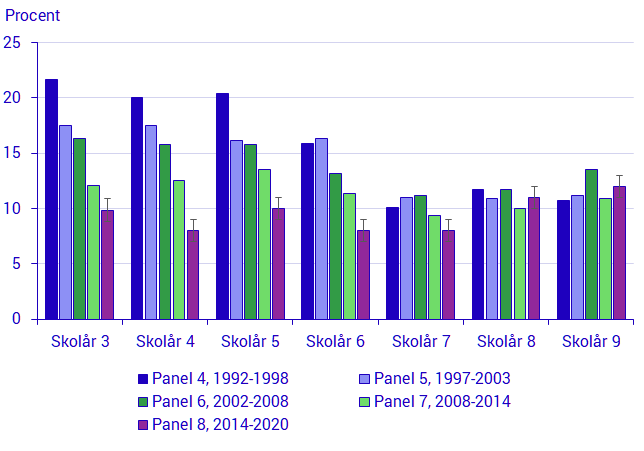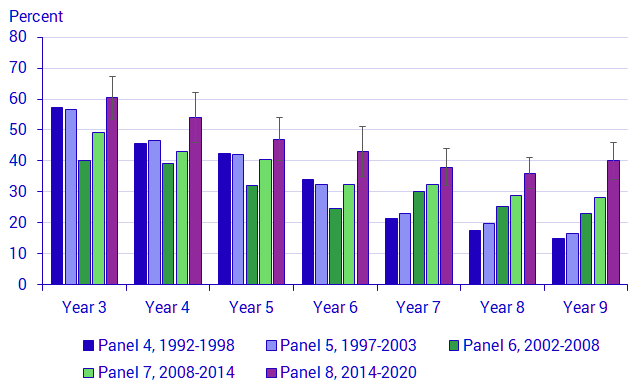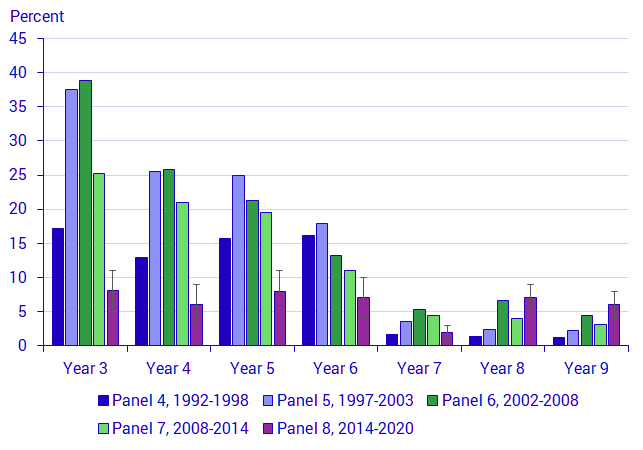Panel of students for longitudinal studies, school year 2019/2020
Remedial education participation rate unchanged from 2019
Statistical news from Statistics Sweden 2020-12-08 9.30
The participation rate over time in remedial education in years 7–9 of compulsory school has been 1 out of 10 pupils. In the 2020 spring term, the participation rate in year 9 was just over 10 percent. This is an increase compared with year 6 in the spring term of 2017 and year 7 in the spring term of 2018.
In the “Panel of students for longitudinal studies” survey, a sample of 10 percent of the pupils in year 3 of compulsory school is followed through years 3–9. In the 2019 spring term, panel 8 was surveyed and the majority of the pupils were in year 9.

About 75 percent of the pupils who took part in remedial studies had an action plan to assist the pupil in reaching the educational goals. In the 2020 spring term, there was no significant difference between the genders in the remedial studies participation rate, while there had been a difference in the previous year, year 7.
There is a difference in the remedial studies participation rate based on the educational background of pupils’ parents. In the 2020 spring term, about 10 percent of the pupils who had at least one parent with post-secondary education participated in remedial tuition, compared with 15 percent of pupils whose neither parent had post-secondary education.
Four in ten foreign born pupils participated in “Swedish as second language” classes
About 10 percent of the pupils who were in year 3 at the start of the panel in the 2014 spring term were born abroad. Between year 3 and year 9, the participation rate in “Swedish as second language” classes among foreign born pupils dropped from 60 percent to roughly 40 percent. Among pupils born in Sweden, the participation rate in year 9 was just below 5 percent.

It was more common for foreign born pupils whose neither parent had post-secondary education to participate in “Swedish as second language” classes, compared with pupils who had at least one parent with post-secondary education. Among the pupils whose neither parent had post-secondary education, roughly 50 percent participated in “Swedish as second language” classes in the 2020 spring term. Among pupils who had at least one parent who had attained post-secondary education, the corre-sponding rate was 35 percent. This difference is not statistically significant in year 9, although it was in year 6.
Over one third of foreign born pupils participated in mother tongue tuition
In year 9, roughly 35 percent of the foreign born pupils participated in mother tongue tuition. About 60 percent of foreign born pupils who attended mother tongue tuition also attended “Swedish as second language” classes. The participation rate was roughly the same for boys and girls in both “Swedish as second language” and in mother tongue tuition.
Rate of pupils in mixed level groups unchanged from 2019
The rate of pupils in mixed level groups was about 5 percent in year 9, which is at the same level as in previous years in panel 8, except for in year 7, which noted a significantly lower rate.

Definitions and explanations
The “Pupil panels for longitudinal studies” survey has been conducted since the early 1980s. A sample of 10 percent of the pupils in year 3 of compulsory school is followed through years 3–9. Most of the pupils were born 10 years before the first follow-up occasion. Comparable surveys have been conducted for pupils who were born in mainly 1967, 1972, 1977, 1982, 1987, 1992, 1998 and 2004. Follow-up surveys are conducted each spring and data is collected from the schools that the pupils attend at the time of the survey.
In the 2020 spring term, panel 8 was surveyed. Panel 8 consists of a sample of 9 800 pupils who attended year 3 in the 2013/2014 school year. Since this is a sample survey, the estimations are marred by a sampling error. In the 2020 spring term, the response rate was 74 percent.
Since the samples are drawn in year 3, pupils who moved to Sweden after year 3 are not included; nor are pupils included who sometime during years 3–9 were enrolled in a compulsory school for pupils with learning disabilities.
Statistical Database
More information is available in the Statistical Database
Feel free to use the facts from this statistical news but remember to state Source: Statistics Sweden.
